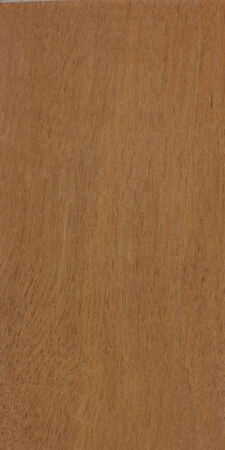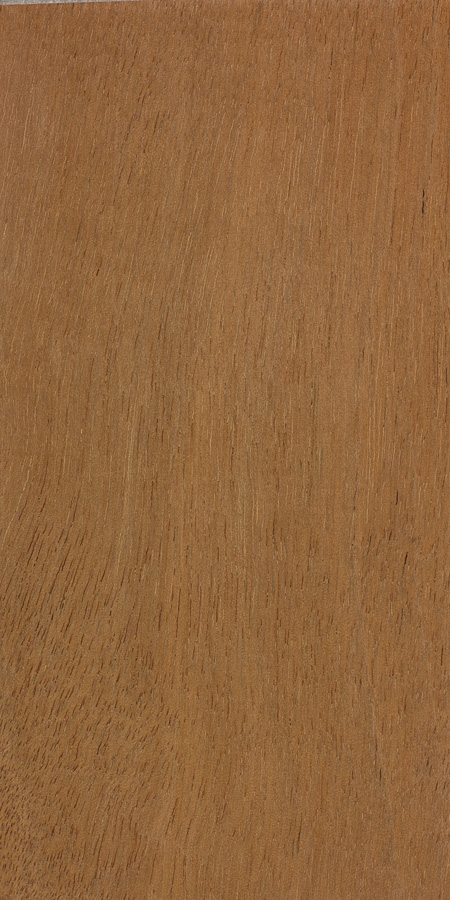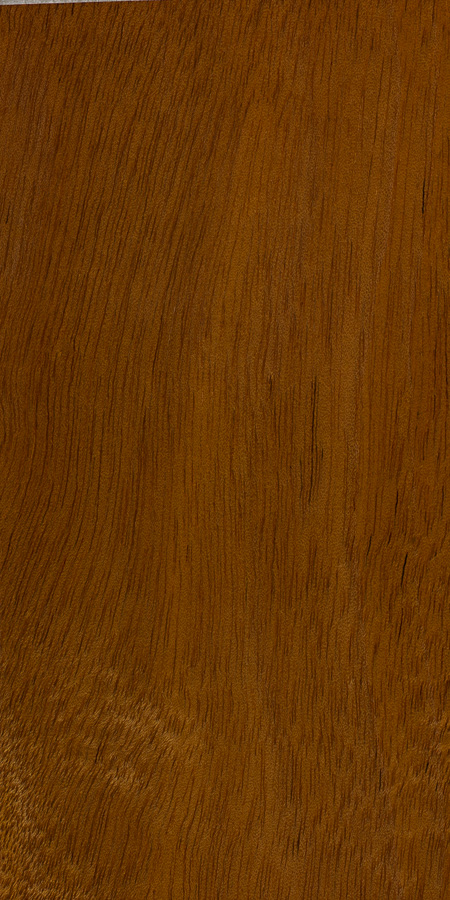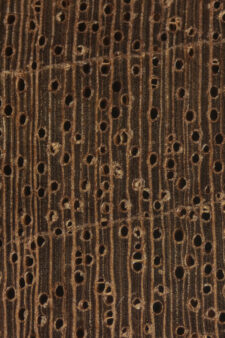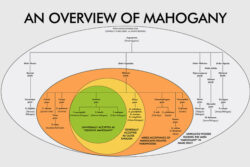Common Name(s): African crabwood, gobi
Scientific Name: Carapa grandiflora and C. procera
Distribution: Tropical West Africa east to Uganda and Tanzania
Tree Size: 30-50 ft (9-15 m) tall,
2-3 ft (.6-1 m) trunk diameter
Average Dried Weight: 43.3 lbs/ft3 (695 kg/m3)
Specific Gravity (Basic, 12% MC): .58, .69
Janka Hardness: 1,180 lbf (5,250 N)
Modulus of Rupture: 14,790 lbf/in2 (102.0 MPa)*
Elastic Modulus: 2,141,000 lbf/in2 (14.77 GPa)*
Crushing Strength: 8,560 lbf/in2 (59.0 MPa)*
Shrinkage: Radial: 4.8%, Tangential: 7.7%,
Volumetric: 12.7%, T/R Ratio: 1.6*
*See comments below regarding strength and shrinkage.
Color/Appearance: Heartwood tends to be a pale reddish brown, darkening with age to a medium to dark brown. Sapwood is a lighter pink or pale brown, not always demarcated from heartwood. Quartersawn surfaces with interlocked grain can exhibit a ribbon-like appearance similar to sapele or African mahogany.
Grain/Texture: African crabwood has a uniform, fine to medium texture with a medium natural luster and a straight grain, though the grain is sometimes wavy or interlocked.
Rot Resistance: African crabwood is considered moderately durable regarding decay resistance.
Workability: Overall easy to work with both hand and machine tools. Sometimes pieces with interlocked grain will cause tearout during surfacing operations. Glues, finishes, and turns well.
Odor: No characteristic odor.
Allergies/Toxicity: There have been no health effects associated specifically with African crabwood, though this may be due to its relative obscurity. However, other Carapa species have been reported cause eye and skin irritation, as well as sneezing. See the articles Wood Allergies and Toxicity and Wood Dust Safety for more information.
Pricing/Availability: Rarely exported on a large commercial scale, African crabwood is used much more often within its natural range as a local hardwood.
Sustainability: Not listed in the CITES Appendices, and the two primary Carapa species harvested as African crabwood are listed as being of least concern by the IUCN.
Common Uses: Cabinetry, flooring, and furniture.
Comments: The two species that make up the African crabwood grouping have similar but only slightly overlapping distributions. Carapa procera is primarily found in tropical regions of West Africa, while populations of C. grandiflora are more centralized in Uganda and Tanzania in East Africa, with an overlapping distribution in DR Congo.
Images: Drag the slider up/down to toggle between raw and finished wood.
Do you have images of projects made from this wood species? You can submit them to me here.
Identification: See the article on Hardwood Anatomy for definitions of endgrain features.
Porosity: diffuse porous
Arrangement: solitary and radial multiples of two to four; sometimes predominantly in radial multiples
Vessels: large to very large, few to very few; dark brown deposits sometimes present
Parenchyma: vasicentric, banded (marginal)
Rays: narrow to medium width; normal spacing
Lookalikes/Substitutes: Although African crabwood typically lacks the visual interest and grain figuring of some pieces of genuine mahogany (Swietenia macrophylla), both woods are from the Meliaceae family, and anatomically, crabwood can be very difficult to distinguish from true mahogany. Swietenia species tend to have stronger, more contrasted and consistent marginal parenchyma bands, while Carapa species may have faded or non-continuous parenchyma bands. Also, Swietenia species have storied rays which can produce ripple marks on flatsawn surfaces—though this feature isn’t always present on all samples, so its presence would point to Swietenia, while its absence would still be ambiguous.
Notes: None.
Related Content:

